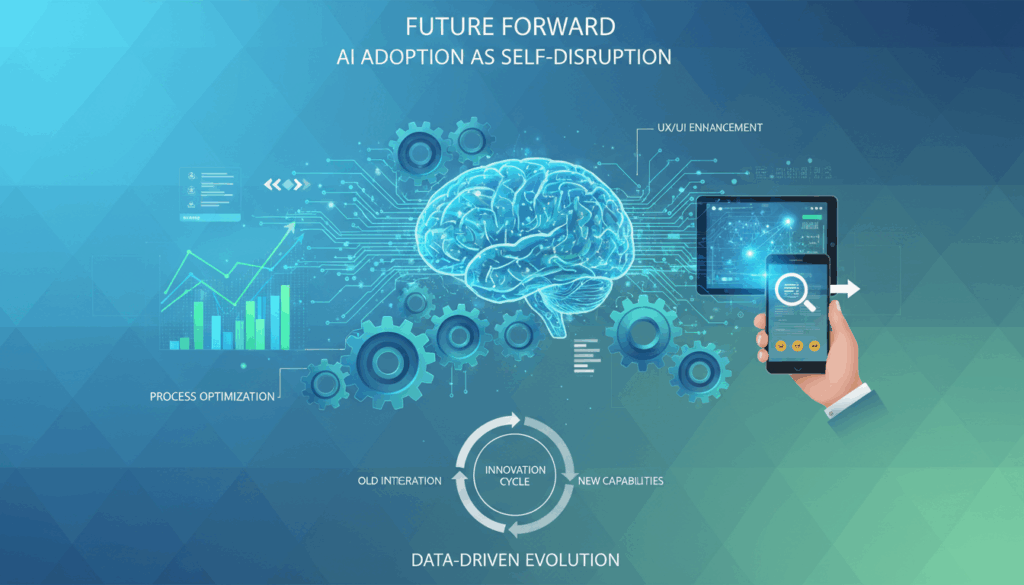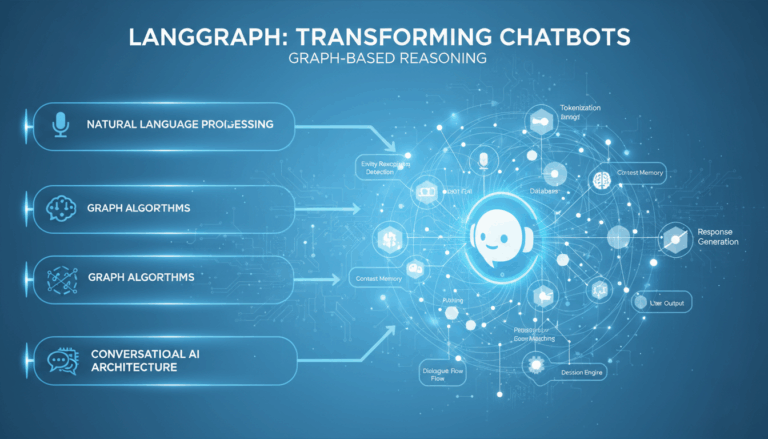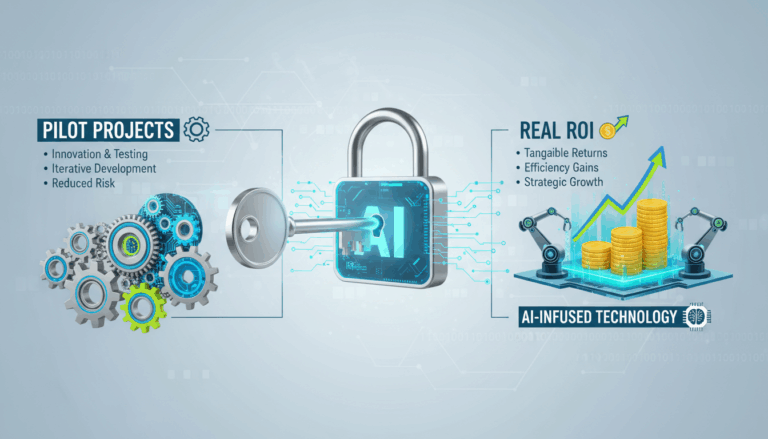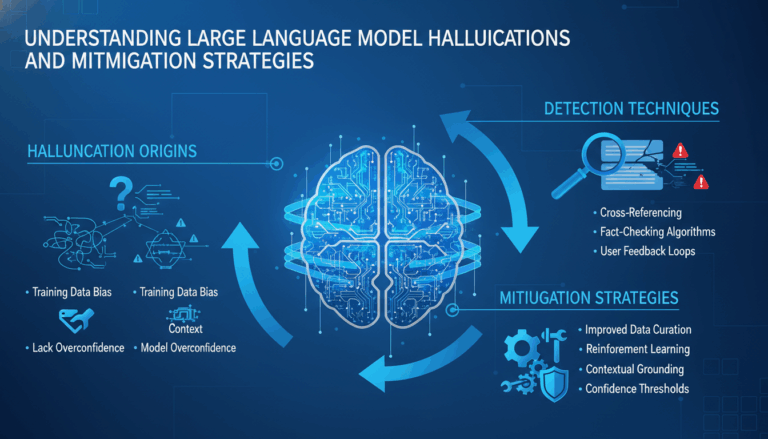Understanding Self-Disruption in AI Adoption
In the rapidly evolving landscape of artificial intelligence (AI), businesses are facing the intriguing yet challenging concept of self-disruption. This phenomenon occurs when a business proactively adopts new technologies that may significantly transform or even obsolete its existing products, services, or processes. Embracing self-disruption through AI involves a strategic shift that requires organizations to reconsider their operational paradigms, redefining their pathways to innovation and market leadership.
Taking AI adoption a step further involves understanding that self-disruption isn’t just about implementing new technology; it’s about fostering a culture that encourages experimentation and agility. Organizations need to cultivate an environment where change is embraced, and risks are acknowledged as necessary components of growth. Startups, for example, often integrate AI from the ground up, allowing them to pivot more rapidly compared to larger companies entrenched in traditional methodologies.
One of the fundamental aspects of self-disruption is identifying the areas within the business model that are most vulnerable to AI advancements. Companies should conduct thorough assessments to determine which processes can be enhanced by AI technologies. This includes evaluating customer service, product development, and supply chain management to identify opportunities where AI could add value or streamline operations.
For instance, in customer service, AI-powered chatbots can handle repetitive inquiries, freeing human staff to deal with more complex issues and improve customer satisfaction. In product development, AI can assist in analyzing market trends and consumer behaviors, guiding product innovations more aligned with consumer demands. Furthermore, machine learning algorithms can transform supply chain logistics by predicting demand and optimizing inventory management.
However, self-disruption requires not just technological changes but a systemic and strategic overhaul. Leadership must communicate the vision and benefits of AI-driven transformation clearly to ensure organizational buy-in. This involves training and reskilling employees to engage with AI technologies effectively. Investing in education and developing a technologically fluent workforce can help mitigate resistance, turning potential barriers into facilitators for successful AI integration.
A notable example of self-disruption can be seen in the automotive industry, where traditional companies are reinventing themselves to compete with tech-savvy newcomers. Firms like Ford and General Motors are investing heavily in AI to develop self-driving technology, a strategic move to disrupt their own traditional vehicle offerings before external competitors do.
Ultimately, understanding self-disruption in AI adoption is about foresight and strategic execution. It’s about positioning an organization to not just survive but thrive in an ever-accelerating technological landscape. By embracing AI as a lever for self-disruption, businesses open themselves up to transformative possibilities that can redefine industries and drive them toward future success.
Key Insights from the UX Magazine Interview with Brian Solis
The interview with Brian Solis in UX Magazine presents a profound exploration of self-disruption through the lens of AI adoption. Solis emphasizes that for companies to genuinely leverage AI, they must rethink their traditional business models and operational paradigms, embracing what he terms as “digital Darwinism.” This concept highlights how businesses need to evolve by aligning their strategies with changing customer behaviors and technological advances.
One of the key takeaways from the interview is the importance of viewing AI as an integral part of customer experience transformation. Solis argues that AI should not only be seen as a tool for automation but as a means to create more meaningful and personalized engagements with customers. For example, companies can utilize AI-driven insights to tailor their marketing efforts, offering personalized recommendations and services based on consumer data analytics. This personalization can drive loyalty and enhance satisfaction, turning transactional relationships into more profound, emotive connections.
Solis also discusses the challenges companies face when adopting AI, particularly the cultural resistance within organizations. He points out that instilling a mindset oriented towards innovation requires breaking down silos that often hinder cross-departmental collaboration. This requires leaders to communicate a compelling vision of how AI can redefine business success, and to create an inclusive environment where employees are encouraged to experiment and disrupt traditional approaches.
Moreover, Solis highlights the need for ethical considerations in AI deployment. He suggests that as companies increasingly rely on AI for customer interactions and decision-making, they must ensure transparency and fairness in their AI algorithms. This involves regularly auditing AI systems for biases, maintaining accountability for AI outcomes, and prioritizing customer privacy and data security.
To illustrate these points, Solis refers to companies that have successfully navigated the path of self-disruption by integrating AI into their core operations. These companies often show adaptive leadership, where leaders not only support technological innovation but actively champion it, fostering a culture where creativity and agility become the driving forces of transformation.
In essence, the insights from the interview underscore the notion that AI adoption extends beyond technology—it’s about cultivating a forward-thinking mindset that champions continuous innovation. Companies must not only invest in AI but also in reshaping their organizational culture to support and sustain this transformation, positioning themselves strategically to thrive in the age of digital Darwinism.
Case Studies: IKEA and Airbnb’s Self-Disruption Strategies
IKEA and Airbnb provide compelling examples of companies embracing self-disruption through their strategic use of technology and innovative business practices.
IKEA has long been synonymous with affordable furniture and a unique shopping experience. However, recognizing the need for transformation in a digital-first era, IKEA chose to disrupt its traditional retail model. A key move was their acquisition of the AI startup Geomagical Labs, which paved the way for augmented reality (AR) applications. IKEA Place, an AR app, allows customers to virtually place furniture in their homes before purchasing. This application not only enhances customer experience by allowing better visualization and decision-making but also supports the integration of digital elements into IKEA’s physical stores.
To further redefine its business model, IKEA has been investing in smart home technologies and expanding its e-commerce capabilities. This self-disruption strategy is evident in their experimentation with subscription-based furniture rentals, which align with the growing trend of the sharing economy and appeal to environmentally conscious consumers looking for sustainable living solutions. By leveraging AI to gain insights into customer preferences and market trends, IKEA has transformed its supply chain and design processes to be more responsive and agile.
Similarly, Airbnb has transformed from a simple home-sharing platform into a diversified global enterprise. Realizing the potential and challenges presented by its rapid growth, Airbnb embarked on a path of self-disruption by adopting AI to enhance user experience and operational efficiency. They implemented machine learning algorithms to power their search and recommendation systems, significantly improving personalization by predicting user preferences based on past behavior and reviews.
Airbnb has pushed the boundaries of self-disruption by using AI to enhance trust and safety, a critical component of its platform. The company employs AI-powered tools for fraud detection and to vet hosts and guests, ensuring a safer environment. Additionally, Airbnb’s cutting-edge AI facilitates dynamic pricing models, adjusting rental prices in real-time based on market demand, location, and property features, which enhances competitiveness and optimizes profits.
Both companies illustrate how adopting self-disruption strategies involves more than just integrating new technologies. It requires a cultural shift towards innovation, agility, and customer-centricity. IKEA and Airbnb have effectively used AI not only to enhance operational performance but to redefine their customer engagement in a way that aligns with evolving market demands. This proactive self-disruption strategy sets them apart as leaders in their respective industries, demonstrating the potential for established enterprises to reinvigorate themselves amidst rapidly changing technological landscapes.
Balancing Optimism and Caution in AI Integration
Integrating artificial intelligence into business operations is marked by an inherent tension between optimism and caution. As organizations worldwide strive to leverage AI’s transformative potential, they must balance enthusiasm for new capabilities with a mindful approach to risks and challenges.
Embracing AI technology involves optimism about improved efficiency, innovation, and customer personalization. Companies often anticipate significant gains from automating repetitive tasks and enhancing decision-making with data-driven insights. For example, AI’s ability to process and analyze vast amounts of data can uncover patterns and trends that were previously invisible, offering invaluable foresight into consumer behavior and market shifts.
However, this optimism must be tempered with caution. Organizations need to consider ethical implications and the potential biases embedded in AI algorithms. Such biases can inadvertently lead to discrimination, especially if datasets lack diversity or represent historical prejudices. Therefore, it’s crucial for companies to implement guidelines for responsible AI development, including regular audits to monitor and correct biases. A robust ethical framework can help ensure that AI technologies adhere to principles of fairness and equity.
Technical reliability and security are other areas demanding a cautious approach. Dependence on AI systems necessitates rigorous testing to ensure reliability and resilience to cyberattacks. Companies should invest in cybersecurity measures and establish protocols for data protection to safeguard sensitive information. The case of AI-driven fraud detection systems exemplifies how businesses can preemptively guard against potential threats by leveraging AI technologies.
Furthering this balance involves preparing personnel for the AI era. Training and upskilling the workforce are essential to minimize resistance and maximize new opportunities presented by AI integration. Organizations can cultivate a learning culture, offering ongoing training programs that equip employees with necessary skills in AI literacy and data analytics.
There is also a need for strategic foresight. Businesses must consider long-term implications of AI integration on their industry landscape and adapt accordingly. Leaders should engage in scenario planning, evaluating potential future states and aligning their strategies to ensure sustainability and competitiveness.
Moreover, transparent communication with stakeholders about the intended and potential impact of AI on company operations is paramount. This involves not only communicating potential benefits but also being forthright about risks and mitigation plans. Such transparency builds trust, crucial for both internal morale and customer relationships.
In conclusion, the integration of AI into business frameworks requires a nuanced approach that carefully weighs optimism against caution. Companies that successfully navigate this balance can harness AI’s transformative potential while safeguarding against its pitfalls, ultimately leading to sustainable growth and innovation.
The Role of Storytelling in Facilitating AI Adoption
In the realm of AI adoption, storytelling emerges as a powerful tool to bridge the gap between complex technological innovations and a broader understanding among diverse audiences. When organizations embark on the journey of integrating AI, communication challenges often arise, stemming from the complexities and potential uncertainties associated with new technologies. Here, storytelling can play a crucial role by humanizing AI, making it more accessible and relatable to different stakeholders, including employees, customers, and investors.
Stories provide context and create meaningful connections, transforming abstract ideas into tangible concepts that audiences can easily grasp. By narrating stories around AI implementations, organizations can illustrate how AI technologies can be integrated into everyday processes to solve problems and enhance efficiency. For example, instead of focusing on the technical jargon of AI algorithms, a company might share a story about a specific AI project that successfully improved customer experience by reducing wait times in customer service interactions through intelligent chatbots.
Moreover, storytelling can demystify AI and alleviate fears or misconceptions that might otherwise hinder adoption. Many employees or consumers may hold apprehensions about AI replacing jobs or infringing on privacy. By crafting narratives that address these concerns head-on, organizations can shift the focus to AI’s role as a supportive tool that enhances human capabilities rather than replaces them. For instance, a company could share testimonials from employees who have experienced positive shifts in their job roles due to AI, highlighting improved job satisfaction and productivity through collaboration with AI tools.
Storytelling also fosters a sense of shared vision and purpose, aligning all stakeholders towards the common goal of successful AI integration. By painting a vivid picture of the potential future state enabled by AI technologies, organizations can inspire and engage their workforce, making them active participants in the transformation journey. This can be achieved through workshops, seminars, and internal communications where leaders share experiences and aspirations about the AI-driven future of the company.
A practical step involves incorporating storytelling into training programs. Instead of traditional, technical-heavy training sessions, workshops that utilize storytelling can illustrate real-world applications of AI, providing employees with relatable scenarios that showcase the tangible benefits of AI tools in their daily tasks. Such narratives can increase engagement and assimilation of new tools.
Additionally, customer-facing stories that highlight success stories of AI implementations can serve as powerful marketing tools, convincing prospective clients of the value and effectiveness of AI solutions. Case studies and testimonials shared via social media, corporate blogs, or presentations at industry events can effectively demonstrate how AI innovations have led to measurable improvements, fostering trust and building brand reputation.
Implementing storytelling effectively involves strategic planning. Companies should identify key messages that align with their AI vision and choose narratives that resonate with their audience’s values and expectations. Engaging storytellers, whether internal champions or external advocates, can amplify the impact, transforming stories into strategic assets for facilitating AI adoption across all levels of the organization.
In every facet of AI adoption, storytelling emerges not as mere embellishment but as an essential communication strategy. It serves to educate, inspire, and unite, weaving a narrative that bridges the complex world of AI technology with the human elements crucial for successful integration and acceptance.




